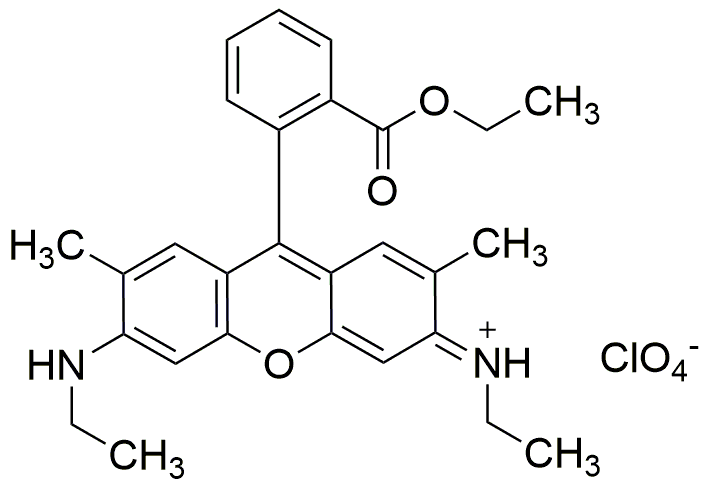Rhodamine 6G perchlorate is widely utilized in research focused on:
- Fluorescent Dyes: This compound is commonly used as a fluorescent dye in various biological and chemical applications. Its bright fluorescence makes it ideal for staining cells and tissues in microscopy, allowing researchers to visualize structures with high clarity.
- Laser Applications: It serves as a laser dye in solid-state and dye lasers. Its efficient light absorption and emission properties make it suitable for generating high-intensity laser beams used in scientific research and industrial applications.
- Environmental Monitoring: Rhodamine 6G perchlorate is employed in tracking water pollution and studying the dispersion of contaminants in aquatic environments. Its fluorescent properties enable easy detection and quantification of pollutants.
- Photodynamic Therapy: In the medical field, it is explored for use in photodynamic therapy, where it can help target and destroy cancer cells when activated by specific wavelengths of light, providing a less invasive treatment option.
- Analytical Chemistry: This compound is utilized in various analytical techniques, such as fluorescence spectroscopy, to detect and quantify different substances, enhancing the accuracy and sensitivity of chemical analyses.
General Information
Properties
Safety and Regulations
Applications
Rhodamine 6G perchlorate is widely utilized in research focused on:
- Fluorescent Dyes: This compound is commonly used as a fluorescent dye in various biological and chemical applications. Its bright fluorescence makes it ideal for staining cells and tissues in microscopy, allowing researchers to visualize structures with high clarity.
- Laser Applications: It serves as a laser dye in solid-state and dye lasers. Its efficient light absorption and emission properties make it suitable for generating high-intensity laser beams used in scientific research and industrial applications.
- Environmental Monitoring: Rhodamine 6G perchlorate is employed in tracking water pollution and studying the dispersion of contaminants in aquatic environments. Its fluorescent properties enable easy detection and quantification of pollutants.
- Photodynamic Therapy: In the medical field, it is explored for use in photodynamic therapy, where it can help target and destroy cancer cells when activated by specific wavelengths of light, providing a less invasive treatment option.
- Analytical Chemistry: This compound is utilized in various analytical techniques, such as fluorescence spectroscopy, to detect and quantify different substances, enhancing the accuracy and sensitivity of chemical analyses.
Documents
Safety Data Sheets (SDS)
The SDS provides comprehensive safety information on handling, storage, and disposal of the product.
Product Specification (PS)
The PS provides a comprehensive breakdown of the product’s properties, including chemical composition, physical state, purity, and storage requirements. It also details acceptable quality ranges and the product's intended applications.
Certificates of Analysis (COA)
Search for Certificates of Analysis (COA) by entering the products Lot Number. Lot and Batch Numbers can be found on a product’s label following the words ‘Lot’ or ‘Batch’.
*Catalog Number
*Lot Number
Certificates Of Origin (COO)
This COO confirms the country where the product was manufactured, and also details the materials and components used in it and whether it is derived from natural, synthetic, or other specific sources. This certificate may be required for customs, trade, and regulatory compliance.
*Catalog Number
*Lot Number
Safety Data Sheets (SDS)
The SDS provides comprehensive safety information on handling, storage, and disposal of the product.
DownloadProduct Specification (PS)
The PS provides a comprehensive breakdown of the product’s properties, including chemical composition, physical state, purity, and storage requirements. It also details acceptable quality ranges and the product's intended applications.
DownloadCertificates of Analysis (COA)
Search for Certificates of Analysis (COA) by entering the products Lot Number. Lot and Batch Numbers can be found on a product’s label following the words ‘Lot’ or ‘Batch’.
*Catalog Number
*Lot Number
Certificates Of Origin (COO)
This COO confirms the country where the product was manufactured, and also details the materials and components used in it and whether it is derived from natural, synthetic, or other specific sources. This certificate may be required for customs, trade, and regulatory compliance.


